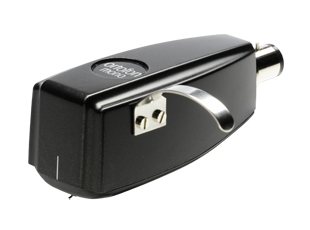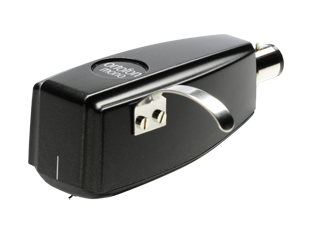The SPU Mono GM MkII provides an authentic method of playing back these early vinyl recordings with remarkable level of sonic accuracy, and its high output negates the need for a moving coil transformer.
#### £ 75 worth of Free Vinyl of Your Choice ######
| Technical data |
|
| Output voltage at 1000 Hz, 5cm/sec. |
3 mV |
| Frequency range at - 3dB |
20-20.000 Hz |
| Frequency response |
20-15.000 Hz + 2 / - 1 dB |
| Tracking ability at 315Hz at recommended tracking force *) |
> 70 µm |
| Compliance, dynamic, lateral |
12 µm/mN |
| Stylus type |
Spherical |
| Stylus tip radius |
R 25 µm |
| Tracking force range |
3.0-5.0 g (30-50 mN) |
| Tracking force, recommended |
3.5 g (35 mN) |
| Tracking angle |
20° |
| Internal impedance, DC resistance |
100 Ohm |
| Recommended load impedance |
47 kOhm |
| Cartridge body material |
Grinded wood |
| Coilwire material |
High Purity Copper (OFC) |
| Cartridge colour |
Black |
| Cartridge weight |
30.5 g |
Ortofon’s SPU cartridges continue the tradition of the first ever Moving Coil cartridges as originally engineered by Mr. Robert Gudmandsen and produced by Ortofon in the late 1950s. Praised for their refined linearity and full body, these cartridges have remained a favorite throughout the years, both for modern and vintage high-end applications.
The latest incarnation of SPU cartridges feature a wood-based integrated headshell to further reduce resonance and provide an authentic and attractive aesthetic.
The Sound Of Excellence
In the late 1950s the iconic SPU cartridge range featured Ortofon’s newly introduced low coil resistance and impedance concept. As a basis for reproducing superb high frequencies, this concept has been continually improved and refi ned in the decades since. With the recent launch of both the SPU Anniversary 85 and MC Rondo cartridges, Ortofon has introduced a new era of wood-based housing structures. The benefi ts of this natural material for cartridge housings mimic the centuries old tradition of hand crafted musical instruments with all the acoustic benefits.
The new developed Ortofon Synergy SPU-cartridge continues the predecessor’s concept whilst adding a new large sound image. The addition of unsurpassed technical data adds up to a highly sophisticated package. The exceptional black polished Urushi painting on the new SPU-housing suggests a precious jewel-like appearance. The musical instrument theme continues - the superb black glazing paint is of a quality found only on famous name pianos. Not only is the visual impression most attractive but the new transducer system allows extraordinary Synergy of sonorous sound. Very low coil-resistance combined with unusually high output (achieved by using Neodymium magnets in a soft iron circuit with high saturation) was decisive for reaching the high signal to noise ratio acheived with the new Synergy SPU-cartridge.
By controlling the cantilever and armature movements in air-gap with very high-magnetic induction, Ortofon has used its comprehensive expertise in designing the right type of damping for the new system. The nude, finely polished elliptical diamond in combination with the aluminium cantilever has both had essential influence on the final frequency-response.
The Mono Microgroove
The mono microgroove geometry is fairly easy to understand, as it only has to contain one signal. That signal is cut in the lateral dimension only, meaning that the V-shaped groove will have constant width and depth. The groove angle of the V-shape will vary a bit from record to record but will always be close to 90 degrees. The top width of the groove will, according to the different standards, have a minimum dimension in order to ensure that the replay stylus can sit comfortably inside the groove. Over the years, this minimum width has varied due to changing standards but has always been close to 50µm until the mid 1960s. The latest standards from the 1980s were revised for a minimum width down to around 30µm. This offered a unified standard, congruent to the minimum width of stereo records.
Regarding the bottom groove radius, old microgrooves from around 1950 could approach 15µm, or even larger if the record stamper was used for too long. Records like that need to be played only by a cartridge with a spherical 25µm stylus, otherwise there is a risk of the stylus bottoming out and causing poor fidelity. From around the mid 1950s, the bottom radius was reduced to around 8µm, which corresponds to the IEC98 standard from 1958 where 7.5µm is stated as maximum radius. Later on, up to the stereo age, this was further reduced down to 4µm. The bottom radius is one of the important factors determining which styli will replay the record satisfactorily .
Understanding the differences in groove types
Mono versus StereoA stereo record contains the left-right information on the two opposing groove-walls that are angled at +/-45 degrees, as is seen in the figure above. Cutting the groove this way leaves us with a complicated shape with both lateral and vertical information which a stereo cartridge is able to read.
A mono record contains only one signal corresponding to left+right which is cut in the lateral direction, so there is no vertical information.
If you play a mono record with a stereo cartridge you will not achieve the same signal in the two channels due to imperfections such as crosstalk, noise, phase errors, tracking error, antiskating and distortion. This difference between the channels will result in an unstable and partially fuzzy image. A mono switch, to some extent, can improve this.
Playing the same record with a mono cartridge will have none of the aforementioned problems, as this cartridge only produces one signal, which afterwards is directed to both channels in the system. This will provide a much more forceful and stable image with a fuller sound.
Another significant advantage of using a mono cartridge to play mono records is the absence of response to vertical movement. This means that a mono cartridge is essentially impervious to the pinching effect which comes into action when the stylus is pushed vertically upward in very narrow grooves. In addition, the response to dust, dirt and wear will be reduced substantially as the vertical component will not be heard. The final result will be a much more clean and noiseless reproduction of the mono record. These effects simply cannot be achieved merely by the use of a mono switch.
The Styli
Spherical styli were the most commonly used geometry up to the beginning of the 1960s. Consequently, most records from the first 15 years of microgroove records have been played with a spherical stylus. This will not, however, mean that mono has to be played with a spherical stylus. In fact, elliptical types as well as line contact types can be highly beneficial for mono records from the mid 1950s and upwards (see figures below). The line contact types, specifically, will ensure an improved high frequency response due to the slim shape. Also the distortion from the pinching effect, which occurs when the stylus is pushed upwards due narrow high frequency grooves, will be reduced substantially.
Replaying an old mono record, which probably has been played only with a 25µm spherical stylus can be replayed in a different unworn location of the groove by using an 18µm spherical stylus or, even better, an elliptical or line contact stylus. Choosing one of these diamond profiles will dramatically increase the stylus’ ability to reproduce the inscription with detail and accuracy.
Lastly, a mono record cut with a properly aligned stereo cutterhead will be no different to using a mono head, as long as the signal supplied is the exact same for both channels. The cutting stylus chosen should also ensure the production of sufficiently deep and wide grooves in order to accommodate those users wanting to replay mono with a traditional spherical 25µm stylus.
One mono cartridge to play all the old and new mono records in existence
Many music lovers still have a lot of mono records in their collections. Many mono records first issued in the 1950s and 60s have also been reissued during the last years, such as Bob Dylan, Miles Davis, and Jimi Hendrix to mention only a few.
One the most significant things happened on the mono frontier has been the release of the Beatles mono box in September 2014.
25µm spherical stylus used in SPU Mono and SPU CG25 Di MkII
18µm spherical stylus used in 2M Mono
Line contact stylus used in MC Quintet Mono, MC Cadenza Mono and 2M Mono SE
#### £ 75 worth of Free Vinyl of Your Choice ######









